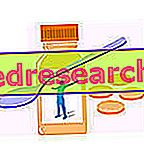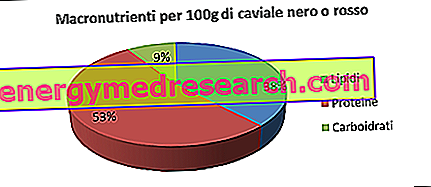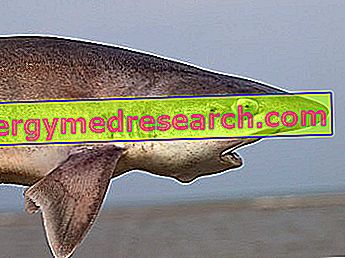What's this
What is the dandelion?
Dandelion - in English, "common dandelion" - is the common name of the dandelion ( T. officinale ), a spontaneous grassy plant of the Composite or Asteraceae Family.

Dandelion is used for both food and herbal purposes; from the nutritional point of view, it is framed in the VI and VII fundamental group of foods, with particular relevance to the latter - given the very high concentration of retinol equivalents (RAE - provitamine A). It also brings many fibers and mineral salts, while energy nutrients are scarce, as are total calories.
Did you know that ...
Other names of the dandelion are: piscialetto (in French pissenlit), yellow star, friar's head, dog's tooth, shower head (referred to the infructescence), donkey chicory, pig's snout, fatteners, brusaoci, pork salad, pisciacane, lappa, missinina, sunflower of the meadows, pork.
In herbal medicine instead, the dandelion - root and / or daughters - are ascribed diuretic, cholagogue or choleretic properties, mildly hypoglycemic, anti-inflammatory, purifying, decongesting and detoxifying for the liver and pancreas; by stimulating the production of bile, cholesterolemia can decrease. It is a well known and widespread remedy of folk medicine.
Widespread throughout the planet, more precisely in the temperate climate zone, the dandelion is rather rustic and does not require particular environmental conditions (soil, humidity, etc.); it seems that it prefers the sunny and ventilated expanses of grass, but not above 200 m of altitude. It is one of the major exponents of the so-called wild herbs or wild herbs and is cultivated only marginally. Very rarely it is used for ornamental purposes; on the contrary, like the wild chicory or wild radicchio, it is considered by gardening lovers as a real weed.
Did you know that ...
The origins of the name "dandelion" could be traced back to the Greek terms "taraxis" (disorder, imbalance) and "akas" (remedy).
Nutritional Properties
Nutritional properties of dandelion
Dandelion belongs to the VI - fruits and vegetables rich in vitamin A - and above all VII fundamental group of foods - fruits and vegetables rich in vitamin C. It is also known for the abundant quantity of fibers, phytosterols, polyphenolic antioxidants and minerals; let's go into more detail.
Dandelion has a very low caloric intake. Energy is supplied mainly by carbohydrates, followed by small amounts of protein and almost irrelevant to lipids. Carbohydrates consist entirely of soluble molecules - fructose monosaccharides and glucose. Peptides have a low biological value, ie they do not contain - in the right quantities and proportions - the essential amino acids of the human protein model. Fatty acids are, in theory, predominantly unsaturated.
The fibers are abundant and in good percentage of soluble type. Dandelion is cholesterol-free and is rich in phytosterols, which have an opposite metabolic effect. It does not contain the molecules mainly responsible for scientifically diagnosable food intolerances, such as gluten, lactose and histamine. Dandelion is poor in phenylalanine and purines. However, it has some anti-nutritional agents, mainly consisting of phytic and oxalic acid and their derivatives (phytates and oxalates), which however decrease significantly after cooking.
As for vitamins, dandelion has excellent concentrations of retinol equivalents (RAE - provitamin A), mainly consisting of carotenoids, lutein and zeaxanthin, and considerable levels of ascorbic acid (vitamin C). However, it especially astonishes the level of vitamin K; vitamin E (alpha tocopherol) is also very important.
The levels of thiamine (vit B1), riboflavin (vit B2), pyridoxine (vit B6) and folate are also far from negligible. With regards to mineral salts, on the other hand, the levels of calcium, iron, magnesium, manganese, potassium and phosphorus are appreciable, although it must be specified that a part of these can remain chelated in the phytates if the food is raw, and everyone can be interested from dilution in drowning cooking; for this, it would be advisable to cook the steam dandelion.
There is a fair concentration of phytotherapeutic molecules of non-vitaminic origin, such as polyphenols - antioxidants.

| Dandelion | |
| Nutritious | Quantity' |
| water | 85.6 g |
| Protein | 2.7 g |
| Lipids | 0.7 g |
| Saturated fatty acids | - g |
| Monounsaturated Fatty Acids | - g |
| Polyunsaturated Fatty Acids | - g |
| Cholesterol | 0.0 mg |
| TOT Carbohydrates | 9.2 g |
| Starch / Glycogen | - g |
| Soluble Sugar | 0.71 g |
| Food fiber | 3.5 g |
| of which soluble | - g |
| of which insoluble | - g |
| Power | 45.0 kcal |
| Sodium | 76.0 mg |
| Potassium | 397.0 mg |
| Iron | 3.1 mg |
| Football | 187.0 mg |
| Phosphorus | 66.0 mg |
| Magnesium | 36.0 mg |
| Manganese | 0.342 mg |
| Zinc | 0.41 mg |
| Copper | - mg |
| Selenium | - mcg |
| Thiamine or vitamin B1 | 0.19 mg |
| Riboflavin or vitamin B2 | 0.26 mg |
| Niacin or vitamin PP | 0.806 mg |
| Vitamin B5 | 0.084 mg |
| Vitamin B6 | 0.251 mg |
| folate | 27.0 mcg |
| Choline | 35.3 mg |
| Vitamin B12 | - mcg |
| Vitamin C or Ascorbic Acid | 35.00 mg |
| Vitamin A or RAE | 508.0 mcg |
| of which beta carotene | - mcg |
| of which uteine zexanthin | - mcg |
| Vitamin D | - mcg |
| Vitamin K | 778.4 mcg |
| Vitamin E or Alpha Tocopherol | 3.44 mg |
Diet
Dandelion in the diet
Dandelion, like most foods in the category - leafy vegetables - lends itself to almost all diets.
Poor in sugar and energy, it has no contraindications for overweight, type 2 diabetes mellitus and hypertriglyceridemia. The dietary fibers contained in it perform many beneficial functions for the body. Especially soluble ones - like inulin - properly associated with water, they can:
- increase the mechanical gastric stimulation of satiety
- modulate nutritional absorption - reducing the insulin glycemic surge and hindering the absorption and reabsorption of cholesterol and bile salts
- prevent or treat constipation / constipation.
This last aspect, essential for the health of the intestine, contributes to considerably reducing the chances of colon carcinogenesis, but also of many other discomforts such as: hemorrhoids, anal fissures and anal prolapse, diverticulosis and diverticulitis, etc. It should also be remembered that soluble fibers constitute a nutritional substrate for intestinal bacterial flora; maintaining the trophism of the microbiota, whose metabolism releases important nutritional factors for the mucosa, the health of the large intestine is further promoted.
Provitamins A, vitamin C, vitamin E, polyphenols and other phytoelements have an important antioxidant role. In addition to counteracting the action of free radicals - guilty of cellular aging - these nutritional elements are considered useful in the treatment of various metabolic disorders. Vitamin K, on the other hand, is an essential anti-haemorrhagic factor. Folate is necessary for the formation of nucleic acids, a very important process during gestation. Vitamins B instead, of which not all vegetables are rich, are coenzymatic factors of great importance.
The richness of water, potassium and magnesium helps to improve the body's hydro-saline balance - which becomes precarious above all with increasing sweating, for example in the case of intense and prolonged sports - and supports the pharmacological treatment of hypertension primary arterial. Water and minerals are two nutritional factors that are often lacking even in old age. Manganese, on the other hand, has important functions as a metal-enzymatic constituent and an enzymatic activation. Calcium and phosphorus, of which the body has a fairly high requirement, are constituents necessary for bone hydroxyapatite and also perform numerous other functions; however, dandelion cannot be considered a primary nutritional source of these nutrients.
Dandelion has no contraindications for: celiac disease, lactose intolerance, histamine intolerance, phenylketonuria and hyperuricemia. In case of pregnancy it is inadvisable to eat raw dandelion; it is possible to disinfect it with amuchina.
It has no limitations in the vegetarian and vegan diet - even raw food - the same applies to philosophies and / or religions of all kinds. The average portion of dandelion is 100-200 g (about 35-70 kcal).
Kitchen
Dandelion in the kitchen
Dandelion is one of the most consumed wild herbs in Italy; it is widely used in Central Italy. It is consumed regularly even abroad.
Dandelion can be eaten raw in salads or cooked. In the first case it is essential to pick it young, before it flowers and bears fruit, when the leaves are light green and bright, free from hair and tender texture; generally at this stage they taste less bitter and sweeter. For cooking instead, which must be by boiling (better by steam) and / or sautéing - with oil and garlic - even larger leaves can be used; it is however not advisable to pick the plants already provided with down. Dandelion salad is usually accompanied by boiled eggs.
Cooked, wild dandelion can be an ingredient for more elaborate recipes of all kinds. As an alternative to spinach, squeezed and minced, it can color fresh pasta with green. Mixed with cheese, spices, ricotta or potato instead, it enriches the filling of stuffed pasta, lasagna, cannelloni and crepes; can be a sauce for dry pasta. Many also use it to stuff roasts, but the most common use is instead in pies or quiche.
Dandelion flowers can be used to produce a drink called "dandelion wine", or more precisely "dandelion flavored wine" - since they are not the main ingredient. It was used in a beer game called "Dandelion" - which literally means "to wet the bed" - produced by "Brasserie Fantôme", in Belgium. Dandelion with burdock is a popular soft drink in the UK.
Another quite famous recipe in the Anglo-Saxon kingdom is dandelion flower jam. In Silesia and other parts of Poland and the world, dandelion flowers with added lemon juice are used to create the so-called "May honey", a substitute for honey.
The toasted dandelion root can be used, similarly to that of chicory, as a substitute for decaffeinated coffee.
Herbalists
Dandelion as a herbal remedy
Dandelion or products made from it are useful for those who want to increase diuresis and / or increase the synthesis of bile and bile flow, to purify / decongest / detoxify the liver.
For more information regarding properties, efficacy, side effects, contraindications, drug interactions, precautions and other uses of dandelions read the article: "Dandelion".
Description
Description of the dandelion
Although the leaves and the root are eaten, the main morphological characteristics of the dandelion are the flower, typically of an intense yellow color, and the infructescence, characterized by small achenes with white feather-like fuzz that form a transparent balloon .
The stem is cylindrical, hollow, bright green like the leaves, with a typically indented border. The root system is a taproot.
Botany
Notes on dandelion botany
Dandelion is a herbaceous plant belonging to the Asteraceae family, genus Taraxacum and officinale species.
Originally from the Eurasian continent, today the dandelion totally colonizes the temperate climate zone and is strongly present also in the American and African continent. In the United States, on the other hand, subspecies and microspecies slightly different from the common European one exist, which are grouped under the names of: ssp officinale, ssp ceratophorum and ssp vulgare .
Tendentially infesting, the dandelion can grow practically anywhere, even between the cracks of asphalt and cement. Its achenes - produced in an amount of about 5000 per year - are highly volatile and can remain alive even for 9 years.
The dandelion is food for the caterpillars of some moths - butterflies and moths - like the moth tortrix celypha rufana .
When foraging on dandelions, honey bees have been shown to lower their pollination activity.



